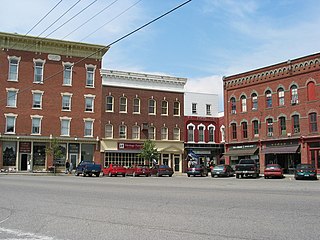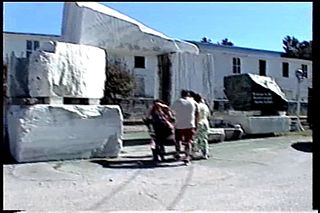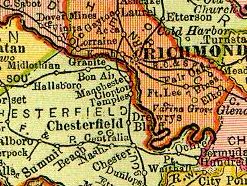Related Research Articles

Slate is a fine-grained, foliated, homogeneous, metamorphic rock derived from an original shale-type sedimentary rock composed of clay or volcanic ash through low-grade, regional metamorphism. It is the finest-grained foliated metamorphic rock. Foliation may not correspond to the original sedimentary layering, but instead is in planes perpendicular to the direction of metamorphic compression.

Buckingham County is a rural United States county located in the Commonwealth of Virginia, and containing the geographic center of the state. Buckingham County is part of the Piedmont region of Virginia, and the county seat is Buckingham.

Caledonia County is a county located in the northeastern part of the U.S. state of Vermont. As of the 2020 census, the population was 30,233. Its shire town is the town of St. Johnsbury. The county was created in 1792 and organized in 1796. It was given the Latin name for Scotland, in honor of the many settlers who claimed ancestry there.

Fair Haven is a town in Rutland County, Vermont, United States. The population was 2,736 at the 2020 census. Within the town is located the census-designated place of Fair Haven. The town is noted for its late 19th century residential and commercial architecture.

Cilgerran is both a village, a parish, and also a community, situated on the south bank of the River Teifi in Pembrokeshire, Wales. It was formerly an incorporated market town.

Bluestone is a cultural or commercial name for a number of dimension or building stone varieties, including:

Lake Bomoseen is a freshwater lake in the western part of the U.S. state of Vermont in the towns of Castleton and Hubbardton in Rutland County. It is the largest lake that lies entirely within the state's boundaries, with a surface area of approximately 2,400 acres (9.6 km2). The lake was formed by glaciation and has an average and maximum depth of 27 feet (8.2 m) and 65 feet (19.8 m), respectively. It drains a 24,770-acre (100.25 km2) watershed, has five major inlets, and empties to the Castleton River, a tributary of the Poultney River, which in turn flows west to East Bay at the southern end of Lake Champlain.

Brownstone is a brown Triassic–Jurassic sandstone that was historically a popular building material. The term is also used in the United States and Canada to refer to a townhouse clad in this or any other aesthetically similar material.

Arvonia is an unincorporated community in Buckingham County, Virginia founded mainly by Welsh immigrants during the 19th century. The town derives its name from the county of Caernarfon, Wales. The county is known popularly simply as Arfon. "Arvonia" is the Latin form of the name. Its major industry has been slate mining. The slate is known primarily for its color and durability, and is featured on many prominent American buildings, such as the Smithsonian Castle, and the University of Virginia. In 1885 Arvon Presbyterian Church was founded to serve the many Welsh miners in the Slate Quarry. The sanctuary portion of the church was destroyed by fire in 2009 and after being rebuilt to its original design, it reopened on Palm Sunday, April 12, 2012.

Buckingham is a census-designated place in and the county seat of Buckingham County, Virginia, United States. The population as of the 2010 Census was 133.

Buckingham Branch Railroad is a Class III short-line railroad operating over 275 miles (443 km) of historic and strategic trackage in Central Virginia. Sharing overhead traffic with CSX and Amtrak, the company's headquarters are in Dillwyn, Virginia in the former Chesapeake and Ohio Railroad (C&O) station, itself a historic landmark in the community. The railroad was featured in the January 2012 issue of Trains Magazine. It is referenced in the How It’s Made episode “Railway Bridge Ties”, showing it crossing a curved bridge.

The slate industry is the industry related to the extraction and processing of slate. Slate is either quarried from a slate quarry or reached by tunneling in a slate mine. Common uses for slate include as a roofing material, a flooring material, gravestones and memorial tablets, and for electrical insulation.

U.S. Route 15 (US 15) is a part of the United States Numbered Highway System that runs from Walterboro, South Carolina, to Painted Post, New York. In Virginia, the U.S. Highway runs 230.37 miles (370.74 km) from the North Carolina state line near Clarksville north to the Maryland state line at the Potomac River near Lucketts. US 15 is a major north–south highway through the Piedmont of Virginia, connecting Clarksville and Farmville in Southside with Culpeper, Warrenton, and Leesburg in Northern Virginia.

The Vermont Marble Museum or Vermont Marble Exhibit is a museum commemorating the contributions of Vermont marble and the Vermont Marble Company, located in Proctor, Vermont, United States. The museum is located in a wing of one of the former Vermont Marble Company buildings.

Tennessee marble is a type of crystalline limestone found only in East Tennessee, in the southeastern United States. Long esteemed by architects and builders for its pinkish-gray color and the ease with which it is polished, this stone has been used in the construction of numerous notable buildings and monuments throughout the United States and Canada, including the National Gallery of Art and the National Air and Space Museum in Washington, D.C., the Minnesota State Capitol, as well as parts of the United States Capitol in Washington, Grand Central Terminal in New York, and Union Station in Toronto. Tennessee marble achieved such popularity in the late-19th century that Knoxville, the stone's primary finishing and distribution center, became known as "The Marble City."

Granite was an unincorporated community in Chesterfield County, Virginia. It was originally located along the Richmond and Danville Railroad five miles west of Manchester and about a mile south of the rapids of the James River along Powhite Creek. Most of the Granite area of Chesterfield County was annexed by the independent city of Richmond on January 1, 1970.

Sag Bridge, Illinois is an Unincorporated community in Lemont Township in southwestern Cook County, Illinois, United States. Sag Bridge is an important waterway junction between the Calumet Sag Channel and the Chicago Sanitary and Ship Canal. It is also the junction of IL 83 and IL 171 which meet at Sag Bridge to cross the Calumet Sag Channel together on the eponymous bridge. The community was named for a predecessor of the present bridge. It is within the village limits and postal delivery zone of Lemont, Illinois.
Buckingham Slate is quarried in Buckingham County, Virginia, in the town of Arvonia. This natural stone has a distinct gray/blue/black color and glistens due to its mica content. One of the highest quality slates in the world, this unfading slate has long been used for architectural applications such as flooring, paving, wall cladding, stairs, counter tops, fireplace surrounds, gravestones and roofing. It has been used on countless prominent buildings and national landmarks, including The Dakota, Ford's Theatre, The Smithsonian Institution, The University of Virginia and Tuckahoe Plantation.

The Woodbury Granite Company (WGC) was a producer of rough and finished granite products. Incorporated in 1887, purchased and significantly reorganized in 1896, and expanded by merger in 1902 and thereafter, the company operated quarries principally in Woodbury, Vermont, but its headquarters and stone-finishing facilities were located in nearby Hardwick. Beginning as a quarrier and seller of rough stone, the company expanded into the business of finishing cut stone and grew from there. It made its name as a supplier of architectural (structural) granite, and grew to become the United States' largest producer, supplying the stone for many notable buildings, including several state capitols, numerous post offices, and many office buildings.
References
- ↑ Delesline, Nate, "New Owners of Shuttered Buckingham Plant Expected to Bring Back Some Jobs." The Daily Progress, Charlottesville, VA. (7/28/12).
- ↑ "James River Slate Company | Vermont Structural Slate Company, Inc". Archived from the original on 2014-03-27. Retrieved 2014-03-27.